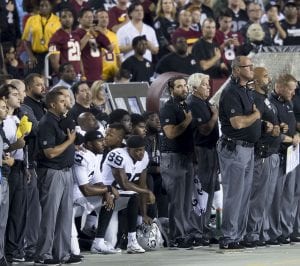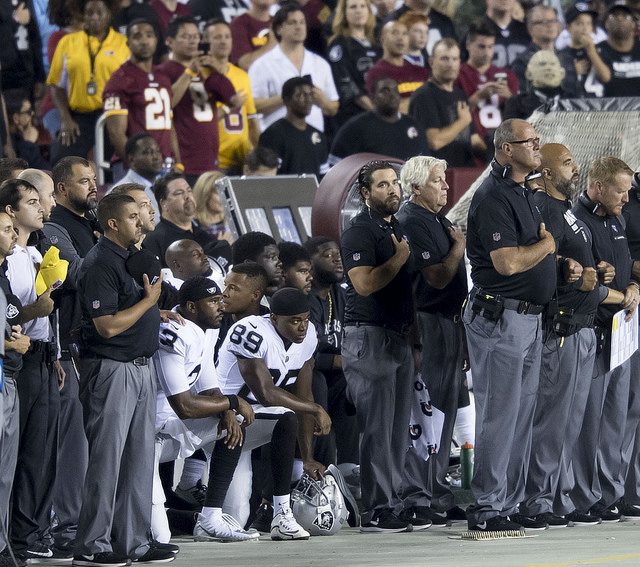
Oakland Raiders National Anthem Kneeling. Photo by Keith Allison via flickr, CC BY-SA 2.0.
Over the last several months, a prominent story has been the #TakeAKnee protest movement. Its catalyst, quarterback Colin Kaepernick has explained why he sat during the national anthem and later “took a knee.”
Along with the events (and murder) in Charlottesville, the debate over keeping or removing white supremacist landmarks, openly white supremacist rallies and unprovoked physical attacks on people of color, debates about who gets to have freedom of speech and in what context, continued unchecked police violence against Black people, white silence, and of course Trump’s constant tweets—there is enough to keep conversations locked, loaded, and going for a long time.
At the core of these conversations is our unacknowledged history. And that same issue also impacts the core of our work.
How our organizations perform—how we frame our work and how we react to structural, institutional, and cultural threats to our stakeholders, customers, and clients—is key. We are constantly faced with the decision of whether to #TakeAKnee in our work, and whether we meet this challenge or not either reinforces our racialized landscape or disrupts it. What is clear is that we cannot sit on the sidelines with a universalist perspective, claiming to do good work.
Whether our organizations work in housing, finance, community development, economic development, or equity (depending on your lens for approaching this topic), below are ways in which we can #TakeAKnee in our own spheres of influence:
Expand the Frame. The framing of national conversations around racialized injustice concentrates the problem on a small group of extremists. By narrowing the frame to explicitly malicious, self-described Nazis, white supremacist, skinheads, or “alt-right” sympathizers, we safely and firmly close the door on examining all the ways in which we, using our own “whiteness lens” (which all Americans have, since we are all inculcated with the same messaging) impact national policy, along with our local institutions and organizations. We leave unexplored the ways in which we do this through racialized communication, program development and implementation, and the ways we evaluate. Without expanding the frame, all of our statements of support can ring hollow if our own organizational practices are examined and found wanting.
Stop Centering White Comfort. The mythology of America is very real, and we often, without irony, use this mythology in our work—even in communicating our support of resistance efforts. We back away from things that might cast us as “divisive” or require us to have honest conversations, if those conversations are about race. We co-opt symbolism while altering its intent (an example: Kaepernick’s stand was against racial inequality and police brutality in communities of color, but in listening to mainstream media’s characterization of it, you’d think it was against Donald Trump and the right to protest in the NFL.) Since November 2016, even the term “resistance” has been co-opted. This term, which in many communities of color refers to resisting and fighting white supremacy, has been co-opted by allies to refer to “resisting” the current president and administration. This more comfortable framing leaves unaddressed the broader, more uncomfortable issues that Kaepernick raised.
Change the Narrative. Too often our organizations are wedded to messaging that tells racially stereotypical stories to funders and others, emphasizing people who are victimized by “broken systems.” In fact, we are rewarded for the messaging with funding and grants. When we tell the stories of “broken systems” we should speak honestly about the history, legacy, and system of white supremacy without soft-selling, or framing it within an implicit bias or other lens (Implicit Bias is real, but it happens within the context of white supremacy, which is why its impact is racialized in ways that are policy-positive for whites and often policy-negative for African Americans and other non-Black people of color). In doing this, we might be punished through loss of funding. We could be branded “radical.”
However, we can #TakeAKnee in ways that are effective in changing the narrative without pushing our organizations into a level of risk they are not willing to assume just by examining the following:
- Who holds the real power on our boards and in our leadership staff?
- With whom are we comfortable? Do we operate from an ideological standpoint (implicitly and explicitly) that centers groups classified as white as standard reference for everything associated with history and culture, or those who do not?
- What is our organizational messaging? Does our discussion of the issues that we work on acknowledge and center the ways in which institutional and structural racism affect behaviors and outcomes? Or is our messaging focused on a “broken people” narrative?
- Do we center the sensibilities of our (majority white) funders and donors? The myths of American fairness, meritocracy, whiteness? Aggregated data which hides racializations and the impact of racializations? Our “whiteness gaze” (which any racial group can adopt)?
- Who do we involve in strategizing, and when? Do we involve those directly impacted? When do we do this, during planning and strategy or to co-sign once a strategy or program is complete?
- Do we acknowledge the experience and expertise of those with and for whom we are working? The people with the expertise of lived experience are those most often left out of conversations and development of program and evaluations that directly impact their futures.
When we say “#ThisIsNotUs,” we are denying the history of this country in favor of how we, as individuals and organizations, see ourselves. In reality, #ThisISUs. White supremacy and racialized inequality are the primary reasons why the work we do is needed, and if we cannot acknowledge and center that reality in our work, then we are deciding to pass on the substance, even if we support the symbolism, of #TakeAKnee.






Comments